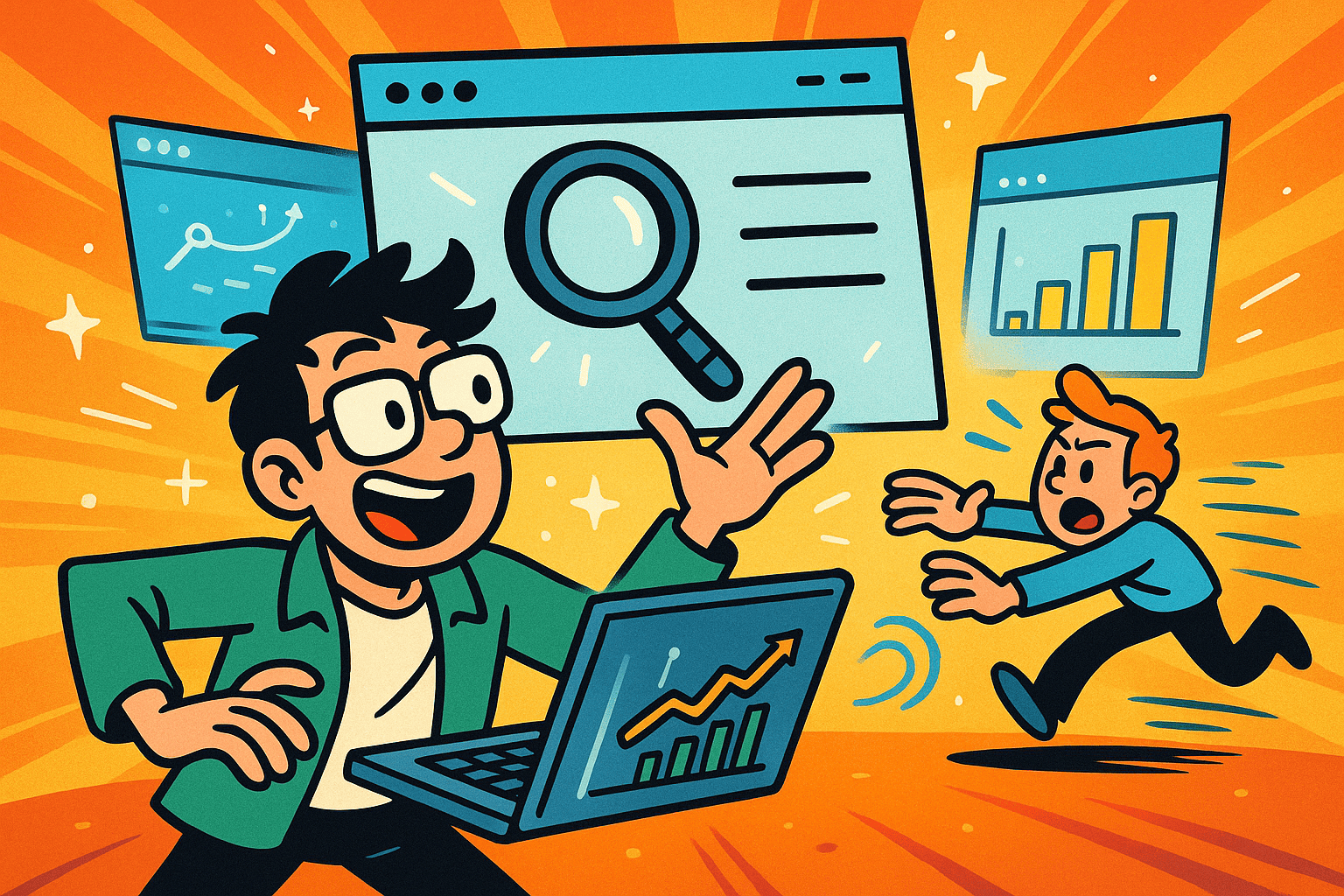💡 Zero-click SEO at a glance for SaaS:
- Users get answers directly on Google SERPs without clicking through.
- Common formats: featured snippets, People Also Ask, Knowledge Panels, AI Overviews.
- Impact: strong rankings deliver impressions but fewer site visits.
For SaaS demand generation leaders, this shift redefines how success is measured. Visibility alone can now build credibility because repeated brand exposure in snippets and panels shapes buyer perception early in the funnel, and your cadence can be planned with the SaaS blog strategy guide.
💡 Instead of equating “rankings = traffic,” the modern SaaS SEO playbook prioritizes brand presence, topical authority, and trust signals over clicks alone. To scale coverage across Q&A clusters (without cannibalization), consider a programmatic SEO strategy and periodically validate zero-click surfaces with AI content audit software.
👉 Want to know where your traffic is being lost in AI Overviews and snippets? Request a Zero-Click SEO Audit
The implication is clear: SEO ROI must expand beyond click-through rates. Growth-stage SaaS companies that embrace impressions, SERP feature ownership, and visibility as performance metrics will not only protect their pipeline but also stay competitive in 2025’s AI-driven search ecosystem supported by lifecycle content mapping for SaaS growth. In this new landscape, exposure equals influence, and influence fuels demand.
Table of Contents
Why SaaS SEO Isn’t Delivering Clicks in Zero-Click SERPs
For SaaS companies, achieving strong rankings used to guarantee a steady stream of organic clicks. Today, however, Google’s evolution into an “answer engine” has changed the rules. Featured snippets, People Also Ask boxes, and Knowledge Panels (plus the broader shift to Google SGE and SEO) now give users the information they need without ever visiting a website.
▶️ For B2B SaaS teams, this creates a frustrating paradox: SEO still drives impressions and visibility, but traffic and leads decline. This section explores why that disconnect happens and what underlying dynamics are at play.
Why isn’t My SaaS Content Driving Clicks Even With Top Rankings?
Think of today’s SERP as less of a “gateway” and more of a destination. A top-three ranking used to guarantee traffic (but now, Google often gives away the punchline before users ever reach your page).
- Featured snippets and AI Overviews summarize your answer directly on the results page, our AI SEO BOFU case study shows how earning citations in these modules protects bottom-funnel intent.
- People Also Ask boxes keep users clicking deeper into Google’s ecosystem instead of your site; structuring your pages with Answer engine optimization services helps you win those “in-SERP” touchpoints.
- Zero-click behaviors satisfy curiosity in seconds, especially for SaaS-related informational queries like “best CRM integrations” or “pricing models.” If older posts are cannibalizing (or feeding snippets without clicks), start with a content pruning guide for SaaS to reclaim demand.
🤙 Want a zero-click impact map for your domain? Book a 30-min Strategy Call
Why are My CTRs Dropping Even Though Rankings Improved?
Ranking gains can feel hollow when the actual clicks don’t keep pace. This drop in CTR, despite stronger positions, is a symptom of Google’s zero-click ecosystem. The dynamic works like this:
- SERP Features Steal Attention – When Knowledge Panels, featured snippets, and “People Also Ask” appear above or alongside your result, they capture user interaction first. Winning these surfaces requires answer-forward structure and schema.
- User Intent is Satisfied Faster – For many SaaS-related searches, especially informational ones, the answer is already displayed in the SERP, reducing the need to click through; our AI SEO success story shows how BOFU visibility still influences pipeline even without a visit.
- Shifting CTR Baselines – A #1 ranking used to mean 30% of clicks; now, it may yield half that depending on the presence of AI Overviews or snippet boxes (see SGE impact on SaaS content for how generative results depress clicks but increase brand exposures).
How do Zero-Click Elements like Knowledge Panels Impact SaaS Brands?
Knowledge Panels shape how prospects see your SaaS brand before they ever visit your site. Their impact can be broken down into clear advantages and drawbacks:
✅ Advantages
- Authority improve: Appearing in a Knowledge Panel signals legitimacy which is helpful for SaaS brands competing in crowded markets.
- Brand recall: Logos, leadership names, and core facts stay visible, reinforcing awareness even without a click.
- Trust factor: Buyers scanning multiple vendors often interpret panels as a sign of credibility.
⚠️ Drawbacks
- Click deflection: Panels often answer key queries (pricing, company size, reviews) instantly, bypassing your product or feature pages.
- Data risk: Google pulls from third-party sources like G2, Crunchbase, or Wikipedia if outdated or inaccurate, it can misrepresent your company.
- Lost engagement: You miss the chance to guide the visitor’s journey with custom messaging, CTAs, or demos.
💡 Bottom line: To capitalize while controlling risk, treat Knowledge Panels as part of your on-SERP experience: monitor sources, align schema, and reinforce brand narratives with scalable thought-leadership and BOFU assets, and build a technical foundation with SaaS SEO consulting to manage entity signals, E-E-A-T, and structured data at scale.
What Keyword Cannibalization Risks are Higher in zero-click SERPs?
| Risk Type | SaaS Example | Impact in Zero-Click SERPs | Why It Matters / What to Do Next |
|---|---|---|---|
| Multiple blog posts on the same topic | Two posts on “SaaS onboarding best practices” | Google may choose only one for a snippet, suppressing the other | Wasted effort + diluted visibility. Audit overlaps with the B2B SaaS content audit checklist and consolidate. |
| Overlap between product and educational content | Feature page on integrations vs. blog on CRM integration tips | Both rank but clicks go to Google’s extracted snippet | Lost traffic from competing against yourself. Use the content pruning guide for SaaS to merge/redirect. |
| People Also Ask duplication | Different answers pulled from your site into PAA | Your brand surfaces multiple times but without driving visits | Exposure without sessions. Standardize Q&As using how to do a content audit to remove duplicates. |
| Fragmented topical authority | Several shallow posts on the same keyword cluster | Google struggles to pick a canonical authority page | Weak snippet/overview ownership. Implement 301s and hub updates via the SaaS content audit & fix sprint. |
How to Fix SaaS Keyword Strategy for Zero-Click SERPs
If zero-click SERPs are eating into your SaaS traffic, the solution isn’t to abandon SEO (it’s to evolve your keyword strategy). Traditional keyword research focused on driving clicks, but in 2025 and beyond, SaaS teams must prioritize visibility, authority, and intent alignment.
👉 The goal is to design a keyword strategy that earns presence in snippets, AI Overviews, and People Also Ask, while still funneling high-intent users into the site. This section explores actionable ways to adapt, making sure your content continues to drive demand even when clicks decline.
→ Book a 20-min Content Review
How do I Pick Keywords for Visibility in Zero-Click SERPs?
When keywords no longer guarantee traffic, you need to evaluate them through a different lens: visibility potential. Instead of asking “Will this bring me clicks?”, SaaS marketers should ask “Will this put my brand in front of the right audience, even without the click?”
Steps to select visibility-first keywords:
1. Identify Queries Likely to Trigger Snippets or AI Overviews
▶️ Look for questions (who, what, how) and definition-style searches. Also prioritize “conversational” and long-tail phrasing that mirrors spoken questions (our guide on voice search SEO for SaaS shows patterns that frequently surface in PAAs and AI Overviews).
2. Segment by Intent
▶️ Awareness terms: Often zero-click but useful for exposure (e.g., “What is SOC 2 compliance?”).
▶️ Consideration terms: Mix of clicks and impressions (e.g., “Best SaaS onboarding tools”).
▶️ Decision terms: Higher chance of traffic (e.g., “{Brand} vs {Competitor} pricing”).
To align research with buying stages, map clusters using this lifecycle content strategy guide before you build briefs.
3. Prioritize Keywords That Reinforce Topical Authority
▶️ Even if CTR is lower, consistent visibility strengthens credibility in your SaaS category. When you need breadth without duplicating thin pages, consider structured coverage via programmatic SEO services to scale FAQs, integrations, or templates responsibly.
4. Map Visibility to Funnel Goals
▶️ Impression-heavy keywords for awareness, click-heavy keywords for lead-gen. If your team needs help turning a mixed-intent list into a revenue plan, bring in SaaS SEO specialists to connect SERP surfaces to BOFU conversion paths.
💡 Takeaway: In a zero-click world, visibility is part of ROI. If prospects consistently see your brand answering questions, your SaaS becomes the trusted option when it’s time to buy.
How do I Optimize Content for Featured Snippets and PAA?
Featured snippets and People Also Ask (PAA) are two of the most common zero-click traps. But for SaaS brands, they also represent prime real estate for visibility, credibility, and authority building. The key is to structure your content so Google sees it as the clearest, most concise answer.
🔑 Optimization Moves for SaaS Content
1️⃣ Answer Directly, Early
Put a one-sentence definition or solution in the opening lines. Example: “SaaS onboarding is the process of guiding new users to adopt your product quickly and effectively.” To increase snippet readiness, align formatting and schema with AEO services for SaaS.
2️⃣ Use Clean Formatting
Bullets, numbered steps, and tables increase your chances of being pulled into a snippet. Keep answers short (40–60 words is ideal). Run a quick on-page check using this content audit walkthrough to trim fluff and tighten answer blocks.
3️⃣ Anticipate People Also Ask
Audit PAA boxes for your target queries. Add those questions as H2/H3s and provide succinct answers in your article. Where overlap exists, consolidate with a SaaS content pruning strategy to avoid duplicate answers competing in SERPs.
4️⃣ Build Authority Context
Don’t just answer; provide a follow-up insight that Google may not surface. Example: after defining onboarding, add “In SaaS, strong onboarding directly impacts retention and expansion revenue.”
5️⃣ Optimize Multiple Formats
Mix FAQs, glossaries, and how-to guides so you cover both snippets and PAA opportunities. For question-style phrasing and long-tail patterns that surface in PAAs, use a conversational search strategy.
What Keyword Research Frameworks Work Best for SaaS in Volatile SERPs?
In volatile SERPs, where Google constantly experiments with AI Overviews, snippets, and shifting layouts, SaaS teams need a repeatable framework instead of chasing single keywords. A framework makes sure consistency, protects against SERP changes, and keeps your keyword strategy aligned with growth goals.
The “Visibility–Intent–Conversion (VIC)” Framework for SaaS
➡️ Visibility Layer (SERP Presence)Focus: Queries likely to trigger snippets, PAA, or knowledge panels.
Example: “What is customer churn in SaaS?” Goal: Secure impressions and authority, even if CTR is low. See how Search Generative Experience changes rankings to gauge visibility potential.
➡️ Intent Layer (Problem–Solution Alignment)Focus: Mid-funnel, solution-driven queries.
Example: “Best SaaS onboarding tools” or “How to integrate CRM with SaaS platform.” Goal: Capture mixed click/zero-click intent while showcasing expertise; map clusters with a lifecycle content strategy.
➡️ Conversion Layer (High-Intent Demand)Focus: Branded and comparison keywords.
Example: “{Your SaaS} vs {Competitor} pricing.” Goal: Drive the clicks that matter most for the pipeline; align BOFU pages with an SEO agency for SaaS firms plan.
✅ Why this works for SaaS
- Balances exposure (top of funnel) with measurable demand (bottom of funnel).
- Future-proofs against Google shifts by diversifying keyword “bets” (expand scalable coverage with a programmatic SEO strategy).
- Anchors SEO in business outcomes, not vanity metrics like CTR.
How Can SaaS Teams Balance Branded vs. Non-Branded Keyword Strategies?
Here’s a comparative table showing how SaaS companies can weigh branded and non-branded keyword investments in a zero-click SERP world:
| Keyword Type | Definition | Benefits for SaaS | Risks in Zero-Click SERPs | Best Use Cases |
|---|---|---|---|---|
| Branded Keywords | Searches including your company or product name (e.g., “{Brand} pricing” or “{Brand} vs Competitor”) | - High purchase intent - Strong control over messaging - Defends brand against competitors bidding on your terms | - Knowledge Panels and snippets may answer without driving clicks - Competitor comparison snippets can steal visibility | - Bottom-of-funnel demand capture - Protecting brand equity |
| Non-Branded Keywords | Generic industry or solution searches (e.g., “best SaaS onboarding tools”, “what is churn reduction?”) | - Expands reach to new buyers - Builds topical authority - Fuels awareness at scale | - High chance of zero-click answers (definitions, lists) - CTR often lower even with strong ranking | - Top- and mid-funnel content; educational resources that reinforce expertise; production via Data-driven SaaS content marketing |
💡 Takeaway: Branded keywords defend revenue. Non-branded keywords grow market presence. A balanced portfolio makes sure SaaS visibility across the full buyer journey.
How do I Future-Proof my SEO Against More Zero-Click Results?
The best way to stay resilient is to design SEO strategies that anticipate, rather than react to new SERP changes. Think of it as building a defensive + offensive roadmap:
🛠 Step-by-Step Playbook
1. Audit Zero-Click Exposure Today
Review where your SaaS brand is already surfacing in snippets, PAA, and AI Overviews. Benchmark impressions vs. clicks to identify visibility gaps , start with a comprehensive SaaS audit list to spot cannibalization and missed SERP features.
2. Double Down on High-Intent Content
Invest in decision-level queries (brand, comparisons, pricing). These remain the least vulnerable to zero-click cannibalization; if you need a BOFU plan, partner with a SaaS SEO agency to operationalize comparison pages and demos.
3. Build Structured Content Formats
Use FAQs, schema markup, and clean definitions so Google can lift your answers accurately. Improves both visibility and brand authority, our AEO consulting agency playbooks focus on snippet/PAA readiness and entity hygiene.
4. Consolidate Topical Authority
Merge overlapping posts into pillar pages to strengthen the signal. Minimizes cannibalization risks in SERP snippets; follow this how to prune SaaS blog content workflow to decide what to merge, redirect, or refresh.
5. Align SEO with Demand Gen Metrics
Redefine ROI in terms of the influenced pipeline, not just CTR. Track visibility impact alongside conversion-focused traffic.
Frequently Asked Questions
Traditional SEO focused on driving clicks from rankings. Zero-click SEO prioritizes visibility in snippets, PAA, and AI Overviews, where users may not click. For SaaS, it’s about brand exposure and authority signals, not just traffic
Measure impressions, SERP feature ownership, and assisted conversions. Success is visibility and influence on the pipeline, not just clicks. Track how consistently your brand appears in zero-click formats and its downstream impact
Plan modular, structured content clusters optimized for both humans and AI. Balance depth with concise summaries, use schema markup, and create authoritative topical coverage to ensure AI tools consistently cite your SaaS brand
Zero-click SEO drives awareness, builds trust mid-funnel, and strengthens positioning. Even without clicks, consistent SERP visibility ensures your SaaS brand is remembered when buyers shortlist vendors
Map SEO intent to funnel stages: awareness for authority, consideration for engagement, and decision for conversions. Integrate with demand-gen tactics to turn search visibility into pipeline and revenue





